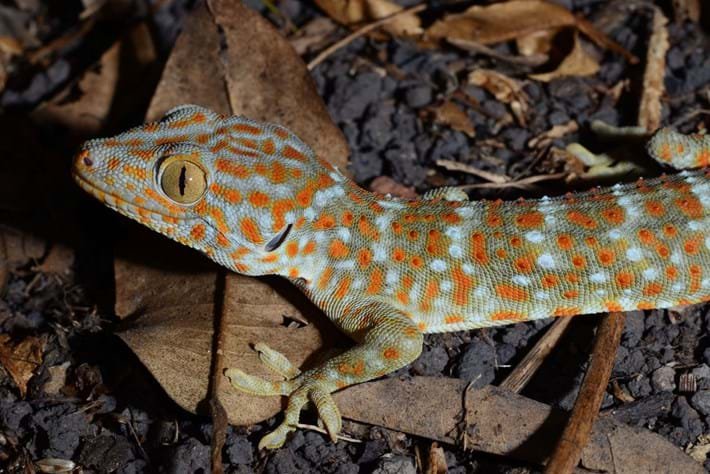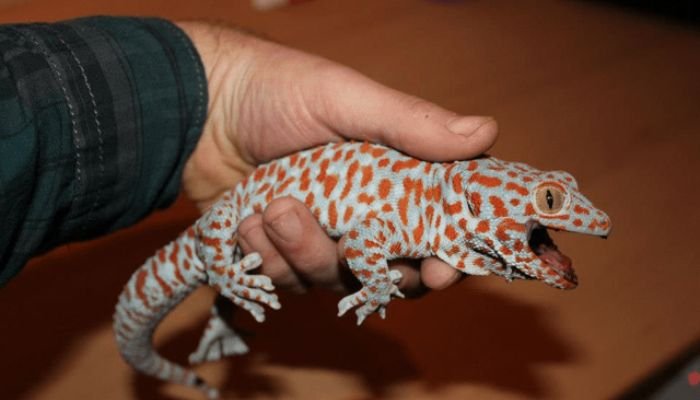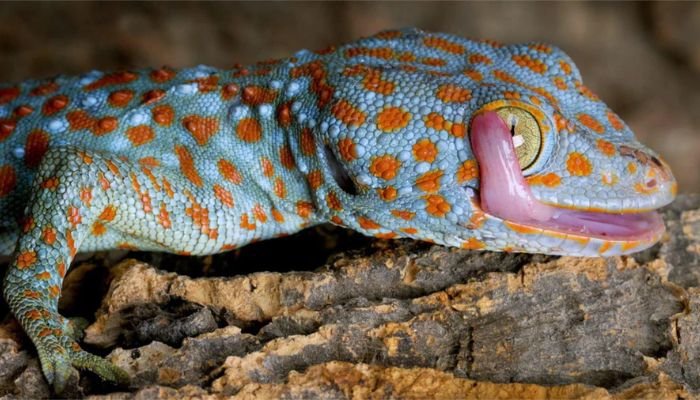
Tokay Gecko is native to Southeast Asia and is distinguished by its vibrant colors and distinct vocalizations. It has successfully acclimated to arboreal environments due to its substantial size and robust grasp. Due to their extraordinary adaptability, these geckos can endure and even flourish in urban environments. Nonetheless, habitat destruction and the illegal pet trade pose a threat to their populations.. Here are Tokay gecko Guide on Food, Habitat, Size, Lifespan & Predators below-
Tokay gecko Stats in Table format
The stats are given below for Tokay gecko
| Reptiles List | Tokay gecko |
|---|---|
| Family | Gekkonidae |
| Type | Lizard |
| Size | Medium |
| Length | Tokay gecko: Up to 8-10 inches (20-25 cm) |
| Color | Tokay gecko: Usually has a bluish-gray or gray coloration with bright blue spots or markings. |
| Weight | Tokay gecko: Usually weighs between 3 to 6 ounces.. |
| Lifespan | 10-20 years (or more) |
| Reproduction | Oviparous, lays eggs |
| Gestation Periods | The gestation period for a Tokay gecko is approximately 60-70 days. |
| Endangered Status | Least Concern (IUCN Red List) |
| Features | Distinct orange or red spots, adhesive toe pads |
| Country & Areas | Southeast Asia, including countries such as Malaysia, Indonesia, Thailand, Philippines, and parts of India and Bangladesh. |
Tokay Gecko Natural Habitat and Distribution
Southeast Asian countries like India, Nepal, Bangladesh, Bhutan, Myanmar, Thailand, Malaysia, Singapore, Indonesia, and the Philippines are all home to the Tokay Gecko (Gekko gecko), a species of gecko. Some of the Pacific Islands are also home to them. Since they spend much of their time in trees, these geckos have evolved effectively to climb and adhere to surfaces like walls and ceilings.
Tokay Gecko Physical Features and Adaptations
Here are some information on Tokay Gecko Physical Features and Adaptations
1. Body Structure
The Tokay Gecko is a large gecko with a short neck and a strong, muscular body. Because of something called “van der Waals forces,” they may stick to surfaces with the help of unique toe pads on their feet that contain lamellae. Their specialized toe pads make it easy for them to scale walls.
2. Coloration and Patterns
The vivid patterns and colors of Tokay Geckos have made them famous. Individuals might vary in the intensity and pattern of the spots or blotches on their normally blue-gray to bluish-green bodies. As a protection measure, the coloring signals to would-be predators that they are poisonous.
3. Defense Mechanisms
Tokay Geckos make alarming, high-pitched chirping or barking noises when they feel threatened or are being handled. Their bite is a particularly effective kind of self-defense. They have been known to bite and hold on if they feel threatened, which can result in serious injuries. They can also avoid predators by removing their tails, a special talent known as “autotomy.” A gecko can use its missing tail to confuse a predator while it escapes. The tail will regrow, but it will not be an exact replica.

Tokay Gecko Diet and Feeding Habits
Here are some information on Tokay Gecko Diet and Feeding Habits
1. Diet Type
Tokay Geckos are insectivores, meaning that insects and other tiny invertebrates make up the bulk of their food.
2. Preferred Food Sources
Crickets, cockroaches, moths, grasshoppers, and even small spiders are among the insects they consume in the wild. They can also be fed commercially supplied insect guts that are fortified with vitamins and minerals while in captivity.
3. Feeding Schedule
The best time to see a Tokay Gecko is after dark because they are nocturnal. That is why it is best to give them food later at night. Adult geckos, depending on their size and health, may need to be fed every other day or once every few days, but younger geckos may need to be fed daily.
Tokay Gecko Housing and Enclosure Requirements
Here are some information on Tokay Gecko Housing and Enclosure Requirements
1. Terrarium Size and Setup
Because Tokay Geckos are climbers, their terrarium should be built at an angle. Adult Tokays require at least a 20-gallon tank, but larger enclosures are ideal, especially for active individuals or groups of geckos. It is necessary to provide them with plenty of branches, climbing structures, and hiding spaces to ensure their comfort and safety.
2. Substrate Options
Coconut fiber, cypress mulch, or reptile carpet are all suitable options for the substrate. Loose substrates, such as sand or gravel, should be avoided because they might induce gastrointestinal distress if consumed.
3. Temperature and Lighting
The terrarium should have a warmer basking area of 85–90 degrees Fahrenheit (29–32 degrees Celsius) and a cooler section of 75–80 degrees Fahrenheit (24–27 degrees Celsius). Heat can be provided by a heat lamp or ceramic heat emitter. Calcium metabolism and general health of Tokay Geckos also depend on exposure to UVB lighting. Use a UVB bulb designed for reptiles, and replace it periodically as directed by the manufacturer.
4. Humidity and Water Needs
Humidity levels of 70-80% are ideal for Tokay Geckos. Daily spraying of the enclosure will do this. Water droplets from leaves and surfaces can be consumed, thus it is also a good idea to provide a shallow water dish for drinking and soaking.
Tokay Gecko Behaviour and Temperament
Here are some information on Tokay Gecko Behaviour and Temperament
1. Activity Levels
Nocturnal animals like Tokay Geckos are typically only seen at night. They usually stay hidden during the day in one of the enclosed areas.
2. Social Behaviour
Tokay geckos have a reputation for being fiercely territorial and prefer to live alone. Unless you want to utilize them for breeding, you should not keep many Tokay Geckos in the same enclosure because they can develop aggressive tendencies.
3. Handling and Taming
In general, Tokay Geckos are not approachable or docile. They are naturally defensive creatures, especially if they feel threatened. Handling them too often might cause stress, therefore it is preferable to limit it to cage cleanings and checkups.
Tokay Gecko Breeding and Reproduction
Here are some information on Tokay Gecko Breeding and Reproduction
1. Mating and Courtship Rituals
Male Tokay Geckos will make loud calls during mating season to attract females, and they will put on elaborate displays to try to win them over. After mating with a receptive female, the latter will lay eggs within a few weeks.
2. Incubation and Hatchlings
Eggs laid by Tokay Geckos are typically hidden in a safe corner of their habitat or a nearby crack. During the breeding season, the female may lay several batches of two eggs. The eggs need to be extracted carefully and then incubated at the correct temperature and humidity in a separate incubator. Baby birds need their own space right after they hatch since they are fully self-sufficient.
Tokay Gecko Common Health Issues and Veterinary Care
Tokay Gecko Common Health Issues and Veterinary Care
1. Respiratory Infections
Inadequate temperature, humidity, or ventilation can lead to respiratory illnesses. The symptoms of a respiratory infection are a runny nose, a stuffy nose, and wheezing. Seek medical attention right away if you think your pet has a respiratory infection.
2. Parasites:
Parasites, both internal and external, are a potential health risk for Tokay Geckos. Parasite infections can be kept to a minimum with routine fecal inspections and clean housing conditions.
3. Metabolic Bone Disease
MBD, or metabolic bone disease, is caused by insufficient calcium and vitamin D3 in the diet or sun exposure. Skeletal abnormalities may result if this illness is not treated quickly.

Importance of Regular Vet Check-ups
If you are new to caring for reptiles, it is especially important to take your Tokay Gecko in for regular checkups so you can keep tabs on its health. Advice on diet, care, and potential health problems can be obtained from a vet who has experience with reptiles.
Conclusion:
The Tokay Gecko is a remarkable lizard due to its eye-catching appearance and unusual adaptations. They need a stable environment with the right lighting, humidity, and temperature to thrive as pets. Due of their aggressive disposition, they should be fed only insects and handled as little as possible. Only experienced keepers should attempt breeding. To maintain their health and wellbeing in captivity, routine veterinarian examinations are necessary.
FAQs
Q: What is the family and Type of a Tokay Gecko?
The Tokay Gecko, or Gekko gecko, is a member of the family Gekkonidae.
Q: What is the average size of a Tokay Gecko?
Tokay Geckos are typically between 10 and 12 inches (25 and 30 centimeters) in total length, tail included.
Q: How long can a Tokay Gecko grow in size and length?
Tokay geckos, including their tails, can reach a maximum length of 14–15 inches (35–38 centimeters).
Q: What colors do Tokay Geckos come in?
Tokay Geckos have a wide variety of eye-catching colors, including blue, green, gray, and even red. Additionally, they frequently have patterns or dots all over their body.
Q: How big can a Tokay Gecko get in weight?
When fully grown, a Tokay Gecko might tip the scales at 150–200 grams (5.3–7 ounces).
Q: How long do Tokay Geckos live?
If properly cared for, a Tokay Gecko can live for 15–20 years in captivity, which is rather lengthy for a reptile.
Q: How do Tokay Geckos give birth?
Rather than giving birth to live young, Tokay Geckos produce offspring by laying eggs. They nest in protected places, and their young emerge around two months later.
Q: How long is the gestation period for a Tokay Gecko?
Tokay gecko eggs need about 60 days to mature and hatch, therefore that is how long their gestation period is.
Q: Is the Tokay Gecko endangered?
Tokay Geckos are not considered an endangered species as of my most recent check in September 2021. However, species’ conservation status may vary over time, thus it is important to keep tabs on the situation.
Q: What are the prey of Tokay Geckos?
Insects and tiny vertebrates, such as crickets, cockroaches, mealworms, and even small mice, make up the bulk of the Tokay Gecko’s diet.
Q: Do Tokay Geckos have any Predators?
Tokay geckos may be preyed upon by snakes, birds of prey, and even larger animals in the wild.
Q: How Fast Does Tokay Geckos Move?
Tokay geckos, in particular, have a reputation for being swift and nimble. They are capable of speeds of 13 to 16 kilometers per hour (about 8 to 10 miles per hour).
Q. What is Bite Force of Tokay Gecko in PSI?
Tokay Geckos have a weak bite compared to larger animals. In the range of two hundred to three hundred pounds per square inch (PSI).
Q. Can we keep Tokay Geckos as pets?
Some people who are really into reptiles keep Tokay Geckos as pets. However, they are better suited for experienced reptile keepers due to the high level of care, specific housing, and handling experience required.
Q. Are Tokay Geckos good for pest control?
Insects like roaches and crickets can be reduced in numbers thanks to the presence of Tokay Geckos, which are expert insect hunters.
Q. Do Tokay Geckos require a UVB light source?
I hope you like reading on Tokay Gecko FAQ Guide on Food, Habitat, Size, Lifespan and Predators.
